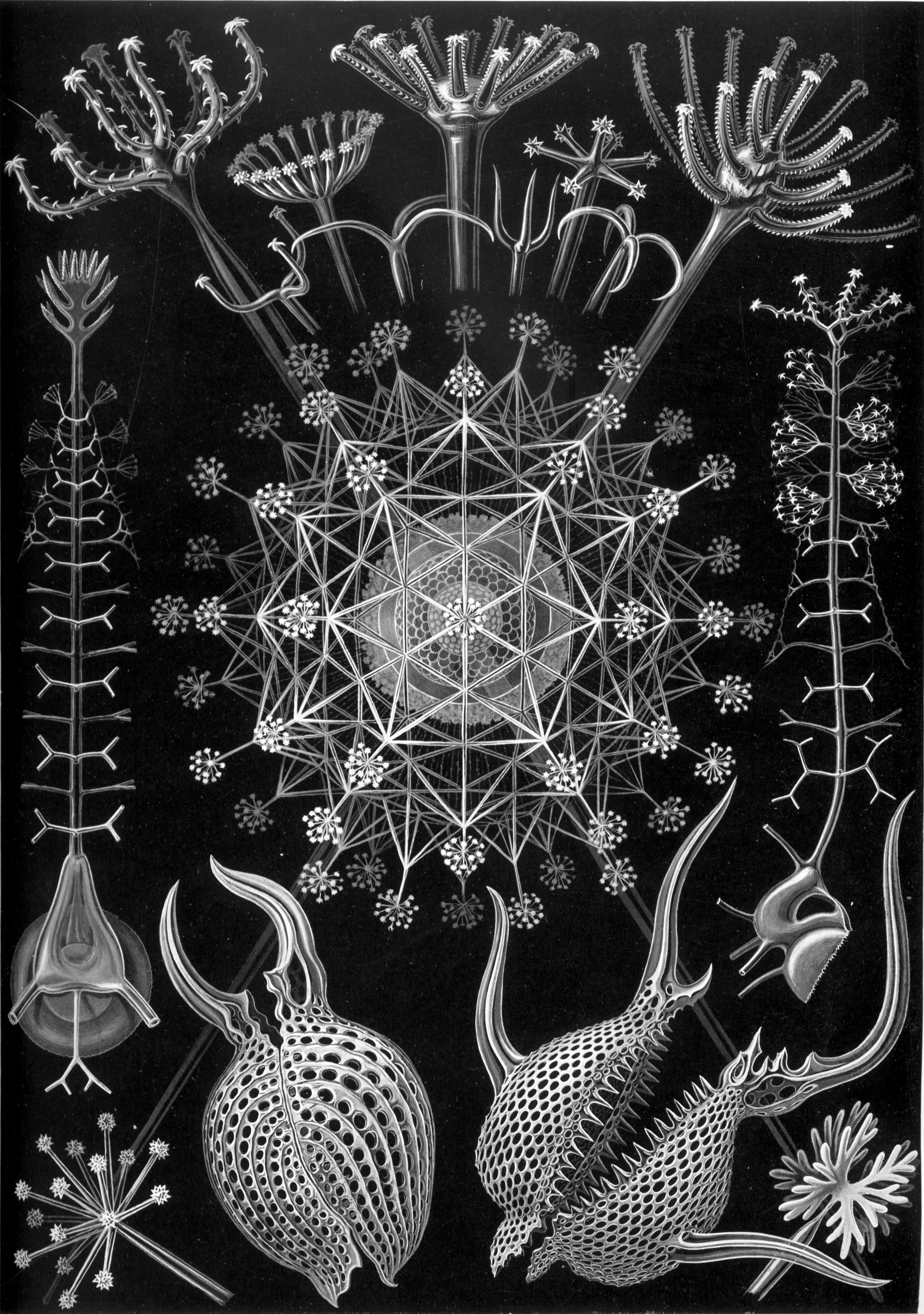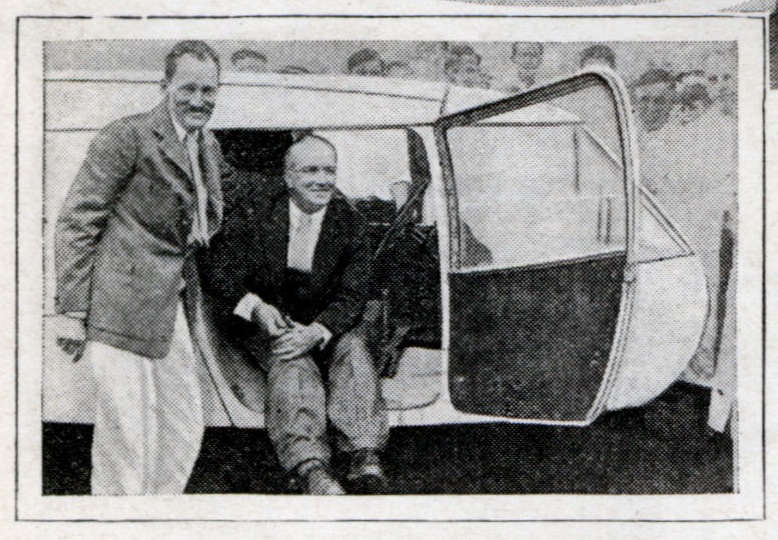Opening of the BFI Study Center
From The Buckminster Fuller Institute:

Throughout the past six months BFI volunteers have worked to redesign our office space in Brooklyn, NY and install a BFI Study Center, open to the public. The center includes rare and out of print books, articles, magazines, photographs, posters, videos, and various artifacts by and about Buckminster Fuller’s life, work, and ideas.
The center also contains the installation of the Dymaxion Timeline, a curated collection of images from the Estate of R. Buckminster Fuller, and the Department of Special Collections and University Archives, Stanford University Libraries, M1090 R. Buckminster Fuller Collection. Organized by Bonnie DeVarco, Shoji Sadao and Beth Stryker, graphic design by Project Projects. The Timeline was presented previously at the Center for Architecture NY (2008) and the Museum of Contemporary Art Chicago (2009) in the context of the Dymaxion Study Center (curated by Beth Stryker, organized by the AIA New York Chapter and the Center for Architecture Foundation in association with the Buckminster Fuller Institute).
The Study Center will be open to the public during set hours and by appointment following the official opening party:
February 3rd, 2010 6-8 p.m.
The Buckminster Fuller Institute
181 N 11th Street, #402
Brooklyn, NY 11211Much thanks to Ben Loeffler and Stephen Martin for their help.
Beverages for the opening provided by Brooklyn Brewery.
- Trevor Blake
Trevor Blake is the author of the Buckminster Fuller Bibliography, available at synchronofile.com
Synergetics Stew January 2009
The Buckminster Fuller Institute published the book Synergetic Stew: Explorations in Dymaxion Dining in 1982. Under this name, synchronofile.com publishes an irregular collection of brief notes relating to Buckminster Fuller.
☂ BLDGBLOG writes about the myriahedral projection map of computer scientist Jack van Wijk (Eindhoven University of Technology in the Netherlands). “Making truly accurate maps of the world is difficult because it is mathematically impossible to flatten a sphere’s surface without distorting or cracking it. The new technique […] uses algorithms to ‘unfold’ and cut into the Earth’s surface in a way that minimizes distortion, and keeps the distracting effect of cutting into the map to a minimum.” Compare van Wijk’s work with Buckminster Fuller’s Dymaxion Map and with Butteryfly Map of Bernard Joseph Stanislaus Cahill.
☂ Speaking of Cahill, Gene Keyes has published a comparison of Cahill’s Butterfly Map and Fuller’s Dymaxion Map. Gene was a student of Fuller’s at Southern Illinois University in Carbondale, Illinois. Nearly 40 years ago Gene wrote Bucky and Pick: Two Grand Designers of a World Without War. An Essay-Review of Robert Pickus (To End War) and R. Buckminster Fuller (Utopia or Oblivion). Fuller sent a handwritten letter to Norman Cousins (editor of Saturday Review) urging Cousins publish the essay. The essay has never been published - until now.
☂ The Imaginary Foundation is selling an “All-Star Pattern Seeker Trading Cards pay tribute to 23 giants of pattern recognition - pathfinders and ideanauts whose shadows loom large across three millennia of discovery. This set of 23 cards comes in a collectible embossed box.” Buckminster Fuller is one of the all-star pattern seekers so honored.
☂ Playboy Magazine mentions Fuller in the profile of Susan Miller (Miss September 1972) and an interview with Allen Ginsberg but some other Fuller information hasn’t made it online yet. This includes the Playboy article “Cities of the Future” from January 1968 and an interview from February 1972. Buckminster Fuller: Anthology for a New Millennium edited by Thomas Zung incorrectly cites Fuller’s Playboy interview in the year 1970. Fuller makes some remarkable claims in his Playboy interview… “I’m not surprised to see women getting naked, because the more naked they are, the more they tend to discourage the sex urge. If a woman is covered up with skirts, man is driven by curiosity. Take away the skirts and he says to hell with it. And I find us getting an enormous amount of homosexuality, which I see as nature supplying us a negative urge that diminishes our capacity to make babies.” “Man probably came to this planet as whole man, a creature very much like what we see today. He might have been sent by electromagnetic waves.” “You could take human beings and inbreed them until you came up with a monkey. You can see that happening every day. Lots of people are halfway to monkey.” See also Buckminster Fuller, Creationist.
☂ Science Daily writes that Salvatore Torquato (Princeton Institute for the Science and Technology of Materials) and Yang Jiao (Department of Mechanical and Aerospace Engineering) have bested the world record set last year by Elizabeth Chen (University of Michigan) for tetrahedra packing. “Torquato and Jiao were able to fill a volume to 78.2 percent of capacity with tetrahedra.” Buckminster Fuller made no specific claims about the closest packing of tetrahedra but would likely have found this discovery of interest.
☂ synchronofile.com had the honor of announcing the restoration of the Dymaxion Car in September 2009. This resulted in a spike of interest in the car both on and off the Internet (see below). Crosthwaite and Gardiner, the company trusted with the restoration, have published some remarkable photographs of their work in progress here and here. Your help is still needed in identifying the source components used in the original Dymaxion Car.
☂ Noel Murphy is filming a documentary titled The Last Dymaxion. “One of the greatest minds of our time designed the very first green car. Certain corporations destroyed the possibility of that car ever being produced, but now, in the 21st century, the last Dymaxion is being restored, and along with it Buckminster Fuller’s Dream.” Noel is also the author/lead in the play Buckminster Fuller Live. The Last Dymaxion is scheduled for release Christmas 2010.
☂ The 1929 automobile of Engelbert Zaschka exhibited features that were important to Fuller. It was a three-wheeled car, like his Dymaxion. But it could also easily be folded, disassembled and re-assembled as could Fuller’s Dymaxion House and many geodesic domes. Zaschka was an advocate and pioneer inventor for the personal helicopter, achieving Fuller’s goal of a personal omnidirectional transportation vehicle. More information at Wikipedia (English, German) German-language excerpt from a television documentary on Zaschka here and a short film of the Zaschka being disassembled here.
☂ Hillary Louise Johnson wrote Super Vixens’ Dymaxion Lounge in 1997. Chapters one through six of Super Vixens’ Dymaxion Lounge are now online. Salon described the book as “a slim but wickedly brutal take on existential life in modern L.A., and one woman’s quest for depth amidst the neon-drenched chaos and urban (not to mention urbane) sprawl. With a toddler in tow all the while. […] Much of the book focuses on Johnson’s search for a way past such hackneyed responses, but she’s also aware of how difficult that is in a town where, a friend tells her, ‘style is substance.’ L.A. is a ‘dymaxion’ town, a term used by Buckminster Fuller to describe a world unto itself, where everything intermeshes and everything is available. So she’s wise enough to know that the idea of breaking through clichés is a cliché itself. Is she really going to be gratified by seducing the Little Caesar’s delivery boy, dating a couple, hanging out with drag queens? Nothing’s ironic in a town built on irony; a teacher at a Montessori school placidly tells Johnson that ‘the playground’s in the backyard, very safe from drive-by shootings.'”
☂ D. W. Jacob’s play R. BUCKMINSTER FULLER: THE HISTORY (and mystery) OF THE UNIVERSE will be performed May 28 - July 4, 2010 at the Arena Stage Crystal City in Washington, DC. Doug tells me: “Crystal City has put out an international call for artists to create outdoor works of art around Bucky themes and concepts, etc.” More information available from the Arena Stage.
☂ Kirby Urner was the first webmaster for the Buckminster Fuller Institute (bfi.org circa 1996 via archive.org). His sites 4D Solutions and grunch.net were some of the first and best online for Fuller mathematics. He was a consultant for textbook publisher McGraw Hill and continues to serve as an educator. Kirby is involved in the Thunderbird Early College Charter School, IEEE, Leadership & Entrepreneurial Public Charter High School, python and linux development and much more. Sometimes Kirby openly promotes Fuller in his educational work, sometimes he works in stealth mode. See a little of both in action at the Oregon Curriculum Network. Kirby’s style is that of a river: as deep as it flows, it also flows swift. He’s on to the next problem before you dry off from the first. Try to catch up with Kirby via Grain of Sand, Control Room , Coffee Shops Network, and the BizMo Diaries. Each of these is generously illustrated with his flickr photo stream.
- Trevor Blake
Trevor Blake is the author of the Buckminster Fuller Bibliography, available at synchronofile.com
4D Syndicate, The First Google Wave for Buckminster Fuller
R. Buckminster Fuller, Education Automation (1961):
I am quite certain that we are soon going to begin to do the following: At our universities we will take the men who are the faculty leaders in research or in teaching. We are not going to ask them to give the same lectures over and over each year from their curriculum cards, finding themselves confronted with another roomful of people and asking themselves, “What was it I said last year?” This is a routine which deadens the faculty member. We are going to select, instead, the people who are authorities on various subjects - the men who are most respected by other men within their respective departments and fields. They will give their basic lecture course just once to a group of human beings, including both the experts in their own subject and bright children and adults without special training in their field. This lecture will be recorded as Southern Illinois University did my last lecture series of fifty-two hours in October 1960. They will make moving picutre footage of the lecture as well as hi-fi tape recording. Then the professor and his faculty associate will listen to this recording time and again. “What you say is very good,” his associates may comment, “but we have heard you say it a little better at other times.” The professor then clubs in a better statement. Thus begins complete reworking of the tape, cleaned up, and cleaned up some more, as in the moving picture cutting, and new illustrative “footage” will be added on. The whole of a university department will work on improving the message and conceptioning of a picture for many months, sometimes for years. The graduate students who want to be present in the university and who also qualify to be with the men who have great powers and intellectual capability together with the faculty may spend a year getting a documentary ready. They will not depend upon diction of the original lecturer because the diction of that person may be inadequate his really fundamental conceptioning and information, which should be superb. His knowledge may be very great, but he may be a poor lecturer because of poor speaking habits or false teeth. Another voice will take over the task of getting his words across. Others will gradually process the tape and moving picture footage, using communications specialists, psychologists, etc. […]
The documentaries will be distributed by various means. One of the ways by which I am sure they will be distributed eventually has very much to do with an important evolution in communications history which will take a little describing. […] With two-way TV we will develop selecting dials for the children which will not be primarily an alphabetical but a visual species and chronological category selecting device with secondary alphabetical subdivisions. The child will be able to call up any kind of information he wants about any subject and get his latest authoritative TV documentary, the production of which I have already described to you.
You are invited to use your two-way TV to dial-in your superb fundamental conceptioning and information. Join 4D Syndicate, the first Google Wave for Buckminster Fuller. Real-time communication occurs at various times on the second day of each month. Synchronofile has a limited number of invitations to Google Wave available for the first few who request them.
[Update March 2011: Google has discontinued Google Wave.]
- Trevor Blake
Trevor Blake is the author of the Buckminster Fuller Bibliography, available at synchronofile.com
4d House Paper Model

Paper model of the 4D House. Work in progress. Trevor Blake, October 2009.
See models of the 4D House in our gallery and in a 3D video.
- Trevor Blake
Trevor Blake is the author of the Buckminster Fuller Bibliography, available at synchronofile.com
Who Am I?
He was born in the 1800s. He conducted an extensive survey of world resources although he was not formally trained to conduct such a task. This survey of world resources demonstrated to him that the profit motive was getting in the way of the efficient and humanitarian distribution of goods and services. He advocated fully-automated factories, and wrote about energy consumption as the most accurate measure economic value. He was Howard Scott.
He was born in the 1800s. He crossed paths with Technocracy Inc. He wrote about the closest packing of circles. His mathematical work was not in essay form but in poetry. His work was ignored while alive but has influenced many (with and without credit) since his death. He was Frederick Soddy.
He was born in the 1800s. He was an inventor not only of a particular artifact for which he is well known for one, but more importantly of a new method of manufacturing and distribution. He wrote books on creating buildings so large entire cities could be housed inside, and the use of round houses laid out on hex-grid streets. He supported global economic reform based on technological competence rather than profit so that all human needs could be met at no cost to the recipient. He was King Gillette.
He was born in the 1800s. He invented a map of the world that received a United States patent. This map displays all continents in an uninterrupted way. The map can be folded into a globe. He designed a domed building. He was Bernard Cahill.
He was born in the 1800s. He became an inventor from an early age, a practice that never left him. An early death in his family also never left him. He investigated alternative fuel sources, innovative new toilets and octahedron-tetrahedron truss structures as an architectural form. Scientific discoveries have been named after him long after his death. He was Alexander Graham Bell.
- Trevor Blake
Trevor Blake is the author of the Buckminster Fuller Bibliography, available at synchronofile.com
Dymaxion Car Restored
Addendum, 2016: this article was the first public announcement of the restoration of the Dymaxion Car. Since that time, the Dymaxion Car has been restored. For more information on the Dymaxion Car, see synchronofile.com.
The Dymaxion Car of R. Buckminster Fuller is being restored by the company Crosthwaite and Gardiner.
Dymaxion Car #1 was involved in a fatal accident, restored, and later accidentally destroyed in a fire. Dymaxion Car #3 was was bought and sold many times (including being bought and sold by Fuller) and disappeared in the 1950s. It may have been sold as scrap during the US-Korean war. Two of the three Dymaxion Cars are lost forever.
Dymaxion Car #2 was produced by Fuller, Starling Burgess and the 4D Dymaxion Car factory in Bridgeport, Connecticut in 1933. The company that produced the car collapsed in 1934 and Fuller relinquished the vehicle to his employees in lieu of wages. It was discovered in California in the 1960s, having been abandoned. Dymaxion Car #2 was later purchased for the National Automobile Museum in Reno, Nevada USA. The Museum superficially restored the exterior of Dymaxion Car #2. In addition to being displayed at the National Automobile Museum, it was displayed at the Museum of Science and Industry in Chicago in 1973 and the Whitney Museum in New York in 2008. Crosthwaite and Gardiner is now conducting a detailed restoration of the exterior and partial restoration of the interior of Dymaxion Car #2.
Trevor Blake of synchronofile.com has been providing essential research material on the Dymaxion Car to Crosthwaite and Gardiner since February 2009. C&G researcher Phil King wrote: “More and more details are slowly coming out from the archives and from people like yourself, but I must say your information has been the most informative and the most prolific so far. […] I know I keep saying it but your help has been fantastic and you have made a difference.”
synchronofile.com has been granted the great honor of announcing the restoration of the Dymaxion Car - because our readers are now invited to help in the project. Can you identify the manufacturer for this component?



These three photographs depict a component of Dymaxion Car #2. In the US they are called ‘turn signals.’ In the UK they are called ‘indicators.’ It may have been manufactured for a trolley (UK: tram) or a bus. If you can identify the manufacturer for this component please send your answer to Phil King of Crosthwaite and Gardiner at the address below. Say synchronofile.com sent you - and watch this space for further announcements…
- Trevor Blake
Trevor Blake is the author of the Buckminster Fuller Bibliography, available at synchronofile.com
Resources:
- Crosthwaite and Gardiner are specialists in the manufacture of race engines, gearboxes and spare parts for the historic race car industry since 1969. For more information, please email Phil King and see: http://www.crosthwaiteandgardiner.com/
- The Lost Inventions of Buckminster Fuller (Part 2 of 3) by Trevor Blake includes information on the intellectual property issues surrounding the Dymaxion Car.
- Dymaxion Car at Wikipedia.
- Dymaxion at Three Wheelers.
- Motor Vehicle, the patent for the Dymaxion Car.
- Isamu Noguchi’s wooden model of the Dymaxion Car, and Isamu Noguchi seated in the actual Dymaxion Car.
- Buckminster Fuller by Martin Pawley (New York: Taplinger 1990) contains the most detailed information on the Dymaxion Car published to date.
Buckminster Fuller, Creationist

According to a 1991 Gallup poll, 5% of all scientists in the United States are creationists. R. Buckminster Fuller was a member of that elite group. All quotes followed by a number in brackets are from Fuller’s book Synergetics.
Fuller claimed Darwin’s theory of evolution was false. Fuller described Darwin’s theory of evolution as “going from simple to complex; amoeba to monkey to man” [229.02] and “survival of only the fittest species (and individuals within species)” [000.108]. Fuller also described Darwin’s theory of evolution as “an illusion that as yet pervades and debilitates elementary education.” [229.02] “My speculative prehistory has assumed (since 1927) Darwin’s evolution of life from the simple to the complex, accomplished through progressive agglomeration of single-cell amoebas, to be in reverse of the facts.” [Critical Path, page 7]
Instead of Darwin’s theory of evolution, Fuller supported Lamarckian-style creationism (he did not use those terms). Lamarckism is the theory that an organism can pass on characteristics that it acquired during its lifetime to its offspring. Creationism is the theory that humanity was created by God to fulfill a purpose. Fuller claimed that by Lamarckism physical characteristics could be bred into humanity but mental characteristics could only be bred out of humanity. Fuller also claimed it was possible porpoises and whales had human ancestors.
It is easy to breed out metaphysical intellection characteristics, leaving a residual concentration of purely physical proclivities and evoluting by further inbreeding from human to monkey. (Witness the millions of dollars society pays for a “prizefight” in which two organisms are each trying to destroy the other’s thinking mechanism. This and other trends disclose that a large segment of humanity is evoluting toward producing the next millennia’s special breed of monkeys). [229.04]
We can comprehend how South Sea-atoll, lagoon-frolicking male and female human swimmers gradually inbred pairs of underwater swimmers who held their breath in their lungs for ever-longer periods, and after many inbreedings of largest lungers and as many outbreedings of general adaptability organic equipment, the progeny evolved into porpoises and later into whales. [Critical Path, pages 8-9]
Darwin was influenced by Lamarckism. After reading Robert Chambers’ 1884 book supporting Lamarckism, Vestiges of the Natural History of Creation, Darwin determined to put more care into his work than Chambers had put into his. Lamarckism claimed that animals gradually changed over long periods time, that different species had common ancestors, and that one of the forces that caused change in animals was the environment. But while Darwin claimed in the negative that animals unable to adapt to changing environments perished, Lamarckism claimed in the positive that animals able to adapt flourished. While Darwin claimed the agent of change in animals was random mutation, Lamarckism claimed the agent of change in animals was a drive toward perfection. The fossil record and contemporary observations confirm the theories of Darwin and discredit the theories of Jean Baptiste de Lamarck. In mistaking the non-random survival of random mutations as a drive for perfection (“Evolutingly we always acquire the means to come closer to the truth” [542.06]), Fuller was mistaken.
Whales and porpoises and humans are all mammals. Whales and porpoises have an ancestor that walked on land, as do humans. But the last common ancestor between these sea creatures and one that walked on the land died out fifty four million years ago. Humanity has existed for less than two hundred thousand years. It is not possible that whales and porpoises evolved from humans.
Fuller claimed we could guide Lamarckian change through applying our intellect to problem solving. He claimed humanity exists because the universe wants us to solve problems.
Since experience is finite, it can be stored, studied, directed, and turned with conscious effort to human advantage. This means that evolution pivots on the conscious, selective use of cumulative human experience and not on Darwin’s hypothesis of chance adaptation to survival nor on his assumption of evolution independent of individual will and design. [502.23]
Humans were included in the cosmic system’s design to fulfill critical functions in respect to maintenance of the integrity of eternally regenerative Scenario Universe. To arrive full-blown and functioning in its cosmic role, humanity has been given the capability to inventory its tactical resources progressively and to reorient its functioning from an omniautomated behavior to a progressively more conscious and responsible behavioral pattern. [ 265.01]
Principles are entirely and only intellectually discernible. The fundamental generalized mathematical principles govern subjective comprehension and objective realization by man of his conscious participation in evolutionary events of the Universe. [220.02]
Darwin’s theory of evolution is an explanation for why humans exist that does not include a supernatural element. Humanity exists without any particular purpose and without any claim to be special among all other life forms. Fuller disagreed, and in so doing is a creationist. Fuller claimed that humanity exists because an anthropomorphic Universe / cosmic system / God created us. Fuller also claimed humanity, among all living things, exists because we have a function. That function is problem solving. To reject this destiny is to guarantee that humanity will die out. Fuller claimed humanity was discovering the principles of Universe / God and is therefore able to evolve.
So it could be that human beings, wherever they occur in Universe, may be introduced as a means of coping metaphysically with the most complex kinds of local Universe problems, so that each one of us is where the problem-solving of Universe is being transacted. If we were to think of ourselves as things - as china dolls, as kinds of china dolls that would just get smashed up or would just get worn or eroded away - that wouldn’t be very good thinking. It would be much closer to actual Universe to think of ourselves as an absolutely continuous complex process. We are quite possibly the most complex of the problem-solving challenges of the invention that is eternally regenerative Scenario Universe. In this way each of us might be a department of the mind of what we might call god. [311.14]
Generalized design-science exploration is concerned with discovery and use by human mind of complex aggregates of generalized principles in specific-longevity, special-case innovations designed to induce humanity’s consciously competent participation in local evolutionary transformation events invoking the conscious comprehension by ever-increasing proportions of humanity of the cosmically unique functioning of humans in the generalized design scheme of Universe. [165.00]
Science must be seen as a tool of fundamental advantage for all, which Universe requires that man understand and use exclusively for the positive advantage of all of humanity, or humanity itself will be discarded by Universe as a viable evolutionary agent. [826.05]
Humans, like the honeybee, are born ignorant, preprogrammed with hunger, thirst, and respiratory drives to take in chemical elements in crystalline, liquid, and gaseous increments, as well as with procreativeness and parental-protectiveness drives. With their directly programmed drives humans inadvertently produce (what are to them) side effects, which results in their doing the right cosmic regenerative tasks for all the wrong reasons - or without any reason at all. This preliminary phase of preconditioned human reflexing, while lasting millions of years, is a gestative-phase behavior that becomes obsolete as humans metaphysical mind discovers the principles of precession and discovers - only through vast, cumulative trial and error - the pattern experience of both terrestrial and cosmic ecology; whereafter humans will progressively recommit their endeavors in support of the recycling and orbitally regenerative effects, precessionally interproduced by all independently orbiting cosmic systems. This abrupt 90-degree reorientation constitutes the evolutionary stage through which humanity is now passing, wherein humanity will progressively exchange its exclusive preoccupation with self-preservation for that of supporting omni-inclusive, cosmic integrity. [326.13]
Fuller might have resisted the title creationist. He resisted most titles, unless they were titles he coined for himself. He might have been uncomfortable with the company of fellow creationists, or proud to be seen again as an outsider to mainstream scientific thought. How much being a creationist is a mark for or against Fuller is left to the reader. But the fact that Fuller was a creationist is demonstrated by his own words.
- Trevor Blake
Trevor Blake is the author of the Buckminster Fuller Bibliography, available at synchronofile.com
Reference
Fuller, R. Buckminster: Critical Path. New York: St. Martin’s Press 1981.
Fuller, R. Buckminster: Synergetics. New York: Macmillan, 1975.
Fuller, R. Buckminster: Synergetics 2. New York: Macmillan, 1979.
Isaak, Mark: Index to Creationist Claims, Claim CA111. http://www.talkorigins.org/indexcc/CA/CA111.html
Wikipedia: Cetacea. http://en.wikipedia.org/wiki/Cetacea
Wikipedia: Human. http://en.wikipedia.org/wiki/Human
Wikipedia: Lamarckism. http://en.wikipedia.org/wiki/Lamarckism
Wikipedia: The Ancestor’s Tale. http://en.wikipedia.org/wiki/The_Ancestor’s_Tale
Wilkins, John: Darwin’s Precursors and Influences. http://www.talkorigins.org/faqs/precursors/precurstrans.html
4D House in 3D
Buckminster Fuller’s 4D House in three dimensions. A work in progress by Trevor Blake of synchronofile.com. Silent, B/W, 30 seconds.
- Trevor Blake
Trevor Blake is the author of the Buckminster Fuller Bibliography, available at synchronofile.com
R. Buckminster Fuller: THE HISTORY (and Mystery) OF THE UNIVERSE
R. Buckminster Fuller: THE HISTORY (and Mystery) OF THE UNIVERSE
written and directed by D. W. Jacobs
from the life work and writings of R. Buckminster Fuller
May 28 - July 4, 2010
Arena Stage
Washington DC USA
Does humanity have a chance to survive on Spaceship Earth? Explore this question with Renaissance man R. Buckminster Fuller, inventor of the geodesic dome. Join us for an unforgettable journey inside one of the most remarkable minds of the 20th century in a dazzling, virtuoso multimedia performance. A hero of the green movement, Bucky framed many of the great environmental ideas of his time and ours. This is your chance to get to know the man and his world-saving mission in a play “as startlingly funny as it is intellectually stimulating” (San Francisco Examiner). It may not only change your life but the life of our planet as well.
- Trevor Blake
Trevor Blake is the author of the Buckminster Fuller Bibliography, available at synchronofile.com
Buckminster Fuller and the Twelfth of July

Starling Burgess and R. Buckminster Fuller, Dymaxion Car. Modern Mechanix Magazine October 1933.
All of the following occurred on the twelfth of July…
1895 Richard Buckminster Fuller was born.
1910 Richard Buckminster Fuller Senior, Fuller’s father, died.
1917 Fuller married Anne Hewlett.
1933 Fuller completed Dymaxion Car #1.
1938-1939 ‘the main system of general education instruction to go on the air and screen’ according to Fuller’s book Nine Chains to the Moon.
1938 Roger Hewlett wrote a poem for Fuller titled One Chain to a Room.
1940 Fuller vacationed with Christopher Morley and conceived the Dymaxion Deployment Unit.
1957 a United States Marine Corps dome was lifted by helicopter from the deck of the USS Leyte.
1957 Fuller received an honorary doctorate from Washington University in St. Louis, Missouri USA.
1966 Fuller lectured at a NASA Symposium at Southern Illinois University Institute of Technology in Carbondale, Illinois USA.
1967 the Montreal Biosphère was dedicated by Fuller to Anne as a wedding anniversary gift.
1969 the first Public World Game was played in New York City, New York USA.
1970 Fuller received an honorary doctorate from Columbia College in Chicago, Illinois USA.
1974 Matthew Meyerson wrote a haiku for Fuller in the Synergetics Cookbook.
1976 Fuller received and honorary doctorate from the University of New Mexico.
1980 John Cage wrote a poem about Buckminster Fuller.
Fuller died in 1983. Here are some Fuller-related events that happened on the twelfth of July…
1984 a commemorative exhibit titled In Memoriam R B F was shown in Singapore.
1999 Your Private Sky: R. Buckminster Fuller edited by Joachim Krausse published.
2000 Ron Campbell performed Buckminster Fuller: The History (and Mystery) of the Universe at the Lorraine Hansberry Theater in San Francisco, California USA.
2003 the Artaud Theater in San Francisco hosted a Buckminster Fuller birthday tribute.
2004 the US Postal Service issued a stamp honoring Buckminster Fuller.
2008 Bucky’s Ge-Odyssey presented by The Center for Architecture Foundation in New York City, New York USA.
2008 synchronofile.com launched.
2016Trevor Blake published Buckminster Fuller Bibliography.
- Trevor Blake
Trevor Blake is the author of the Buckminster Fuller Bibliography, available at synchronofile.com